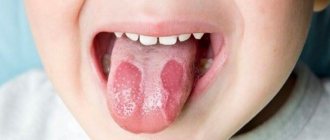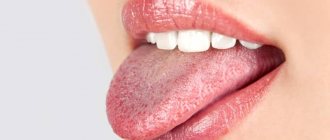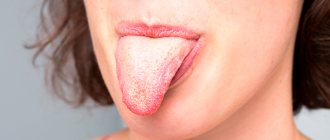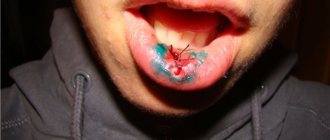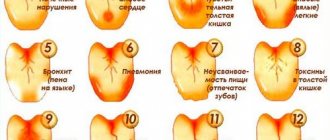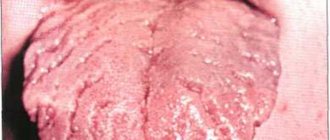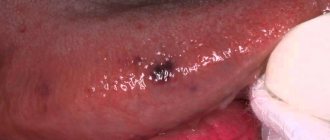May 16, 2018
The tongue is one of the most important parts of the body, because it is the one that first of all signals to us that there is a “problem” in some of the internal organs. Smooth, pinkish mucous membrane without plaque or ulcers is evidence of health, but if you notice cracks in the tongue, then this is a reason to be wary. Their appearance can indicate various diseases and ailments. And if you quickly respond to such a symptom, then in most cases it is possible to solve the problem as soon as possible and avoid complications.
Language is a mirror of health
Read the material prepared by the editors of UltraSmile.ru, carefully examine the language and find out if there is a reason to go to see a specialist.
Main symptoms
Sometimes the presence of cracks and grooves in the tongue is not accompanied by unnatural or painful sensations and can only be detected during examination by a dentist, ENT specialist or therapist. But this doesn't always happen. Patients often complain of the following related problems:
- pain;
- burning sensation;
- feeling that the tongue is loose;
- there is blood and ichor;
- elevated temperature;
- swelling and itching appeared;
- it becomes painful to chew;
- there is a problem with speech;
- increased salivation appeared;
- change in natural color;
- taste disturbance;
- the appearance of an unpleasant odor.
If cracks appear on the tongue, and the phenomenon is accompanied by one of the listed symptoms, then they speak of a progressive disease. This inflammatory process is referred to as glossitis; the prognosis for recovery from it is usually favorable. The appearance of erosions, furrows and ulcers indicates damage to the deep parts of the tongue. In this case, you should definitely contact a specialist.
Sometimes the tongue cracks and becomes covered with ulcers due to general damage to the ENT organs. Thus, tonsillitis or fungal pharyngitis can cause swelling and the appearance of white grooves. This condition is not isolated as an independent disease. Treatment in such cases begins with eliminating the underlying problem.
In adults
Treatment of a similar phenomenon in an adult involves the need to eliminate the underlying complexity that caused the condition.
To do this, perform the following actions:
- The dentist performs a complete sanitation of the oral cavity and the surface of the wound is carefully processed.
- After treatment, the use of antiseptic baths at home is prescribed.
- If there are low-quality orthopedic structures and fillings in the oral area, their edges overhang, the dentist gradually eliminates all these troubles.
Types of glossitis
In total, there are more than ten types of glossitis, three of which are accompanied by the appearance of cracks in the tongue. They have quite pronounced visible differences. To independently diagnose the type, you can compare the current state of the tongue with photos of classic manifestations of the disease.
Folded glossitis takes its name from the main external manifestation - the presence of folds. Sometimes, with this type of disease, a cracked tongue is present from birth. If it does not hurt, is not loose and there are no other unpleasant sensations, then the condition is considered normal. However, with deep cracks in the tongue, treatment is still necessary.
The problem of a folded tongue is often only of an aesthetic nature, although people with this feature are recommended to have constant monitoring by a dentist.
Desquamative glossitis is characterized by focal damage to the surface with almost imperceptible shallow cracks. The papillae desquamate and a whitish heterogeneous layer forms. The affected areas quickly recover, acquiring a natural color, and those adjacent to them become inflamed. The geometry of white areas (plaque) on the surface often changes. In advanced cases, due to the large number of cracks, a person feels the tongue is loose.
Diamond-shaped glossitis is characterized by the presence of a rhombic or oval-shaped area of red-blue color. It is located in the middle of the tongue, in the region of the posterior third. The tongue cracks in the center, so that the entire affected area seems to be divided into two parts. This type can be chronic, and during exacerbations, pain and burning begin.
What is scrotal tongue
A folded (scrotal or grooved) tongue is a genetically determined disease in which this organ has abnormalities in shape, size and surface structure. This disease usually manifests itself in childhood, sometimes from birth. In a child, the grooves are not as pronounced, but the older a person gets, the deeper and more prominent the folds become. By the way, they may not affect the entire organ, but only some part of it.
Interesting! In Latin, the word “scrotum” means “scrotum”, and the tongue is called scrotal because of the similarity of its surface to the skin folds of the scrotum.
Most often, the organ has one longitudinal groove located between the midline of the tongue and its tip. Transverse grooves lead to it, forming a scrotal system reminiscent of the pattern of a large river basin. On the lower part of the organ you can see symmetrical fringed folds.
In accordance with this, the grooves are of several types: fringed, longitudinal (usually the deepest) and transverse (less deep, directed towards the main longitudinal fold).
Localization of cracks
The position of the cracks is not random. Localization is divided into three types, each of which is caused by specific problems. You can independently identify the type of localization by assessing the position of the cracks in the tongue: in the center, on the sides or at the tip.
The presence of cracks only at the tip of the tongue indicates the following causes of the problem:
- Thermal damage. Hot food first comes into contact with the tip of the tongue and causes major damage to it. Often the problem is contact with a hot metal spoon.
- Chemical damage. Occurs from contact with spicy, sour foods or corrosive substances.
- Physical impact. The tip can crack due to an incorrect bite or a cut on the sharp protruding parts of the incisors and canines.
Photo: cracks on the sides of the tongue
The formation of cracks in the tongue in the middle has a different reason, since it is almost impossible to injure this area without touching the periphery. This means that inflammation is an indicator of pathology or disease of internal organs. In addition, the formation of cracks in the center is possible when the middle area dries out, local circulation is impaired, or the immune system is weakened. There may be only one crack; upon examination, it appears as if the tongue has split into two parts.
The presence of cracks on the sides of the tongue can be caused by various reasons. If the inflammatory process is present on the side on one side, then this means physical damage from the sharp edges of small and large molars or dentures. If the tongue is cracked on both sides, it means that there are serious malfunctions in the functioning of the body , where glossitis acts only as an indicator of pathology.
Causes of cracks
Folded glossitis can be detected immediately after the birth of the child. The cause is most often a hereditary predisposition, rather than a sign of any disease. Therefore, if a child has a cracked tongue, this is not yet a reason to start urgent treatment. Only if the grooves bleed or other problems are present should you seek medical help.
The causes of cracks in the tongue can be very different, but they all require diagnosis and elimination. The first type of prerequisites is of a dental nature; the problem arises due to the following phenomena:
- cuts to the organ by sharp edges of teeth or an incorrectly selected prosthesis;
- if diseases of the oral cavity or ENT organs are not treated for a long time;
- irritation from eating excessively hot, spicy, salty or sour foods;
- allergic reaction to medications or toothpaste taken.
The second type of reason, which explains why cracks appear on the tongue, can be described as indicator. It indicates the presence of a disease of the organs or circulatory system.
Another reason for the appearance of cracks in the tongue in adults may be a banal vitamin deficiency, leading to a decrease in immunity. It is usually observed in the following cases:
- the onset of the period from February to April, when there is no supply of vitamins from fresh vegetables and fruits for a long time;
- period of growing up with changes in hormonal levels;
- breastfeeding period.
Deep
Damages that exceed 6 millimeters are considered deep. They are usually caused by cuts from sharp objects, such as bones or other substances.
The basic principles of treatment in such cases are the following:
- elimination of all possible low-quality dentures in the mouth that could cause such a phenomenon;
- carrying out restoration work to restore orthogantic occlusion;
- carrying out diagnostics with the involvement of a dentist, gastroenterologist and therapist;
- taking the necessary medications and performing physical therapy procedures;
- correction of the diet, which involves consuming large amounts of vitamins and substances with healing properties;
- eliminating all bad habits and smoking first.
Medical assistance
If the tongue is cracked and hurts, is swollen on the sides, or there are other signs of the progressive development of the disease, then treatment must be started immediately . A protracted process can progress to a more complex stage, up to necrosis or oncology.
Constant inflammation causes intoxication of the body and is fraught with the entry of pus into the gastrointestinal tract.
Only a doctor can give a qualified answer to the question of why the tongue cracks. Due to the variety of possible causes of cracks in the tongue, the problem arises of which doctor to contact in order to establish the correct diagnosis and prescribe adequate treatment. First of all, you need to get examined by a dentist. This is necessary to identify prerequisites associated with problems in the oral cavity, or to exclude such a scenario.
If, as a result of a dental examination, the cause of cracks in the tongue was not identified, this means that the problem may be caused by diseases of the internal organs. Usually the patient knows or guesses from how he feels about its existence. Depending on the type of possible pathology, you need to contact a specialized specialist.
If there are no obvious signs of illness, you need to consult a therapist or pediatrician. You can first take a general blood test and do an ultrasound of the internal organs.
Medicinal methods
Medicines prescribed by a doctor, the action of which is aimed at treating the crack, will have an anti-inflammatory and healing effect. In such situations, special ointments and gels are prescribed to eliminate painful sensations.
Antiseptic drugs will be useful during treatment. If the crack is caused by diseases of the internal organs, the doctor will prescribe the patient a number of medications that help eliminate the signs of the disease. When the cause of the tongue damage disappears, then its tissues will begin to heal quickly. And gels and ointments will only speed up this process.
Therapeutic treatment
First of all, to get rid of glossitis, it is necessary to diagnose and determine the nature of its occurrence, since it is impossible to cure cracks in the tongue without eliminating the provoking factor. The treatment method should be developed by a specialist in the underlying disease. Additionally, symptomatic treatment of the entire oral cavity is used, depending on the type of lesion. To do this, use the following methods:
- drug therapy aimed at improving local blood circulation in the tissues of the oral cavity;
- prescribing physiotherapeutic procedures such as electrophoresis;
- use of antiviral ointments;
- the use of drugs that stimulate epithelial restoration;
- taking antibiotics for fungal complications;
- administration of local anesthetics for severe pain.
Folded tongue with white spots
Sometimes, in addition to the grooves, white spots appear on the organ. Typically, this symptom is observed in several pathologies at once:
- desquamative glossitis,
- Melkersson-Rosenthal syndrome,
- candidiasis glossitis (damage to the mucous membrane of fungal or yeast-like infections, oral thrush),
- leukoplakia (pathological reaction of the mucous membranes to various irritants. Outwardly it looks like a whitish dense spot that can increase in size),
- sclerosing glossitis (begins with tertiary syphilis). The proliferation of connective tissue in this form of syphilis is accompanied by compaction of the organ and a decrease in its mobility, while the scrotal tongue is soft and loose and has good mobility.
Important! Leukoplakia of the tongue is rarely diagnosed; most often the mucous membranes of the inside of the cheeks, palate and angular folds of the mouth are affected. Leukoplakia differs from geographic tongue by compactions in the area of spots (even warty growths) and can develop into malignant formations.
Use of traditional medicine
At home, you can use well-known methods to help heal wounds in the mouth, eliminate pain, relieve swelling and other symptoms. However, before treating cracked tongue with folk remedies, you need to ensure their compatibility with the prescribed medications.
The most effective are the following recipes:
Herbal infusion of chamomile, celandine, sage and calendula. For adults, you can add St. John's wort. Take after meals in the form of baths or lotions. Promotes wound healing and relieves swelling.- Compresses from fermented milk products. Soften scars and scabs. The procedure should be done in the morning for 15 minutes.
- Sea buckthorn or olive oil. In the morning you need to drop a few drops on the mucous membrane and in the middle of the tongue, then do not drink or eat for 15 minutes. Softens dry formations on the tongue and mucous membranes.
- Honey. Has wound-healing and antimicrobial effects. A piece of the product can be placed in the middle of the tongue and dissolved. Gives a good effect if cracks bleed.
- Propolis tincture (for adults only). The strongest disinfectant: has antimicrobial, antibacterial and anti-inflammatory effects. Since alcohol tincture cannot be used in its pure form if there are open wounds, you need to dilute 1 teaspoon in 100 grams of warm tea. Drink after meals.
Desquamative
Glossitis on the tongue, as in the photo, is scientifically called desquamative, migratory or exfoliative1, but popularly this disease is better known as “geographic tongue”, because in appearance it resembles a geographical map with clearly defined continents in the form of bright red areas of the affected area. mucous membrane.
The photo shows the geographic language
The disease most often develops in the fair half of humanity, more often during pregnancy due to metabolic disorders, when the expectant mother lacks vitamins and useful nutritional minerals. Also, pathology often develops against the background of chronic lesions of the gastrointestinal tract, burns of the mucous membrane and acute allergic reactions.
It is worth knowing that this form rarely develops into an acute stage, so if characteristic signs appear, you should not wait for accompanying symptoms, such as pain or swelling - you should immediately consult a doctor.
Lifestyle change
If a person’s tongue is covered with cracks, then it is necessary to exclude irritating factors when eating. This means that you need to remove hot, hot and spicy foods from your diet. It is necessary to limit the intake of store-bought and homemade marinades, sauces, and fried foods.
A balanced intake of vitamins A and B will help improve your general condition, which will have a beneficial effect on the speed of the process of getting rid of cracks. To provide the body with B vitamins and carotenes, you need to eat plant foods. Vitamin A and B12 are found in high concentrations in animal liver, dairy products and fish oil. In winter, if there is a shortage of vegetables and fruits that have not undergone deep heat treatment, it is necessary to take multivitamins.
Careful oral hygiene is required. It is better to clean teeth from plaque using a soft brush to avoid physical impact on the injured surface of the tongue, especially if it hurts.
Smoking is a significant problem because nicotine contributes to the development of stomatitis and gingivitis, diseases that often accompany glossitis . If your tongue is cracked, you should not drink strong alcohol, as it will cause burns to open wounds, which will take a long time to heal.
If a patient detects cracks in the tongue, doctors talk about a serious stage of glossitis, which must be treated urgently. In most cases, the treatment prognosis is favorable, and the technique depends on the causes of the disease, the neglect of the process and the presence of concomitant pathologies. The speed and effectiveness of therapeutic measures is directly related to how the patient complies with the recommendations of doctors.
